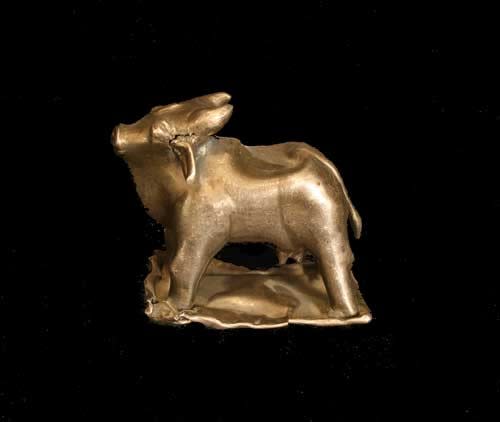Gupta Silver Cow, 320 CE - 600 CE
Silver
1.75 x 2.75
SP.466
Further images
To our modern persuasion and sensibilities, the worship of the cow seems odd. It is not a Particularly strong or intelligent animal, nor is it stunningly beautiful. Yet the sacred...
To our modern persuasion and sensibilities, the worship of the cow seems odd. It is not a Particularly strong or intelligent animal, nor is it stunningly beautiful. Yet the sacred cow is a religious icon that has remained intact for over four-thousand years. The absolutely picturesque piece before us is a fantastic example of the talent and love that has been put into the worship of the cow. This piece, wrought of fine silver- one of the softest and most difficult mediums of metal with which to work, exemplifies at once the grandeur and the gentleness of the era that produced it. The Gupta Empire, commonly thought of as the Golden Age of Indian civilization, stretched itself across one of the largest land-masses an empire has ever occupied. Under the hand of its rulers, Indian art, science, and culture reached a dazzling apex that is every bit comparable to the great renaissances of Athens, Rome, and Europe. But the Gupta Empire was not inoculated with the egotism and individualism that thrived through the western ages of greatness. The master-artist of this piece dedicated his time and energy to immortalizing the pastoral, the benign, the natural, and the motherly. The cow- so carefully detailed with its doleful eyes, its wide-set hips, and placid smile represents what India and its people set in silver, prized and worshipped. This cow is representative of a people who, despite every aspect of refinement and every trapping of culture, manage to continue their love and worship of what is rustic and what is feminine. In a world of conquest, capitalism, and material progress, the gentle, nurturing nature of the milk-provider may have its significance overlooked. But upon staring a this magnificent piece, upon being reminded of the homage once paid to the great matriarchal creature, we might catch our breath, and remember to be grateful for the pastoral pleasures life has to offer- and the beauty and sacredness of our own inner-cow.





